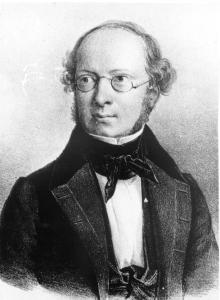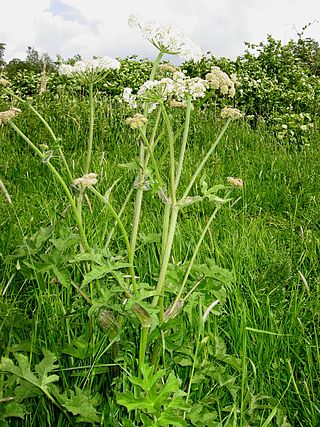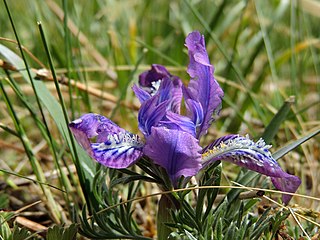
Heracleum is a genus of biennial and perennial herbs in the carrot family Apiaceae. They are found throughout the temperate northern hemisphere and in high mountains as far south as Ethiopia. Common names for the genus or its species include hogweed and cow parsnip.

Johann Friedrich Gustav von Eschscholtz was a Baltic German physician, naturalist, and entomologist. He was one of the earliest scientific explorers of the Pacific region, making significant collections of flora and fauna in Alaska, California, and Hawaii.

Alexander Georg von Bunge was a Russian botanist. He is best remembered for scientific expeditions into Asia and especially Siberia.

Carl Sigismund Kunth was a German botanist. He was also known as Karl Sigismund Kunth or anglicized as Charles Sigismund Kunth. He was one of the early systematic botanists who focused on studying the plants of the Americas. Kunth's notable contributions include the publication of Nova genera et species plantarum quas in peregrinatione ad plagam aequinoctialem orbis novi collegerunt Bonpland et Humboldt. This work spanned seven volumes and was published between 1815 and 1825.

Carl Friedrich von Ledebour was a German-Estonian botanist.

Heracleum sphondylium, commonly known as hogweed or common hogweed, is a herbaceous perennial plant in the carrot family Apiaceae, which includes fennel, cow parsley, ground elder and giant hogweed. It is native to most of Europe, western Asia and northern Africa, but is introduced in North America and elsewhere. Other common names include cow parsnip or eltrot. The flowers provide a great deal of nectar for pollinators.

Festuca altaica, also known as the altai fescue, or the northern rough fescue, is a perennial bunchgrass with a wide native distribution in the Arctic, from central Asia to eastern North America. It was first described in 1829 by Carl Bernhard von Trinius. It is under the synonym F. scabrella, the rough fescue.
Carl Anton von Meyer was a German, Russified botanist and explorer.
Ledebouria grandifolia is a species of flowering plant in the Asparagaceae family. It is endemic to Yemen. Its natural habitats are subtropical or tropical dry forests and rocky areas.

Eremopyrum is a genus Eurasian and North African plants in the grass family. One species, Eremopyrum triticeum has become widely established as a weed in parts of North America.

Ledebouria socialis, the silver squill, wood hyacinth, or leopard lily, is a geophytic species of bulbous perennial plant native to the Eastern Cape Province of South Africa. It was first described by John Gilbert Baker as Scilla socialis in 1870. John Peter Jessop later revised the genus Scilla and split off several species, reclassifying Scilla socialis into the genus Ledebouria in 1970. It is often cultivated and grows well with minimal care.

Allium hymenorhizum is a Eurasian species of wild onion in the amaryllis family. It grows at elevations of 1100–2700 m
Ledebouria floribunda is a species of flowering plant in the Asparagaceae family. It is a bulbous geophyte native to South Africa, Eswatini, and Lesotho.
Endocellion glaciale is a species of flowering plant in the family Asteraceae, native from central Siberia to the northern Russian Far East. It was first described by Carl Friedrich von Ledebour in 1845 as Nardosmia glacialis.

Gagea pauciflora is an Asian species of plants in the lily family. It is native to Mongolia, Russia, and China.

Iris tigridia is a plant species in the genus Iris, it is also in the subgenus Iris and in the section Pseudoregelia. It is a rhizomatous perennial, from Kazakhstan, Russia, Mongolia and China. It has dark green or greyish green, grass-like leaves, a short slender stem and a single flowers that are either violet, dark blue, blue-purple, dark purple, mauve, lilac, lavender, or light purple. It is cultivated as an ornamental plant in temperate regions.

Spergularia marina, also called Spergularia salina, is a species of flowering plant in the family Caryophyllaceae. It is known as salt sandspurry or lesser sea-spurrey. S. marina is a sprawling annual or sometimes perennial, with stems up to 35 cm (14 in) long. Like other sea-spurrey species, its flowers have white to pink petals, with sepals usually longer than the petals, at 2.5–4 mm (0.1–0.2 in). Plants are salt-tolerant, being found by the sea and in saline areas inland.

Heracleum sibiricum is a species of flowering plant in the family Apiaceae. It is native to Europe and western Asia, ranging from France and Italy to western Siberia and Mongolia.
Ledebouriella is a monotypic genus of flowering plants belonging to the family Apiaceae. It only contains one known species, Ledebouriella multiflora(Ledeb.) H.Wolff.
Eremurus spectabilis, is a species of flowering plant in the family Asphodelaceae. It is widely distributed from the eastern Mediterranean to the Caucasus.













